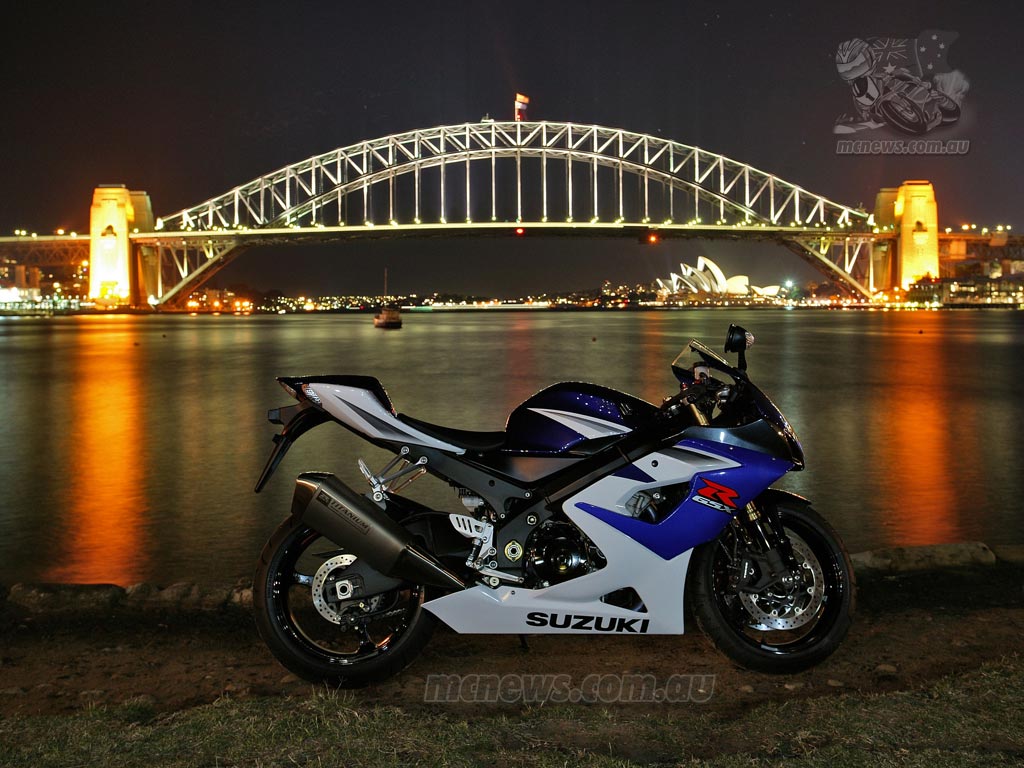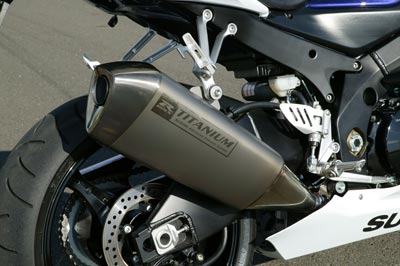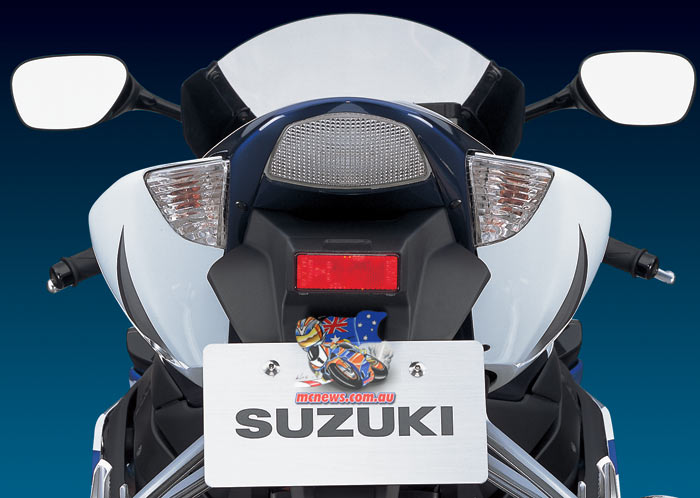The GSX-R1000 K5 might have been launched to the world press Down Under but, there’s no doubt, the Gixer King is back on top of the heap…
I’m the first to admit that I’ve always had a soft spot for GSX-R1000s. I love the stonking engine and the rawness of the bike. There’s no denying it, though. Suzuki was getting well overdue for a new 1000 when the ZX-10R and R1 hit the streets and tracks in 2004. But, as if anything less was expected, the response from the street superbike Gods of Creation is nothing short of astonishing. Yes, Suzuki has raised the bar once again. And no, as is the case every year, I really don’t see how sportsbikes can get any better than this…
First off let get the technical stuff out of the way…
— Engine —
The ’05 Gixer powerplant has been refined and re-worked to compliment the new chassis – starting with an increase in capacity from 987.7cc to 998.6cc through an increase in bore from 73.0mm to 73,4mm. Stroke remains 59.0mm. The basic engine dimensions remain the same despite the increase in bore, with cylinder pitch at 80mm and the same horizontally split crankcases and crank/input/output shaft layout as the K4. Cylinder angle is 23 degrees.
A new cylinder head features a more compact combustion chamber design with a higher compression ratio of 12.5:1 over the previous model’s 12.0:1. The higher compression ratio helps increase power and torque throughout the rev range while the new combustion chamber design and flat valve head, combined with larger intake and exhaust ports, contribute to better combustion efficiency. The new valves are titanium, replacing last year’s steel jobbies and saving 94.4 grams in the process. The lighter valves and heavier springs have enabled a 1000rpm higher rev ceiling.
New pistons and rings also help reduce mechanical losses, with the piston skirts new 8.9mm narrower and piston height 1.3mm smaller. And despite an increase in width of 0.4mm per slug, weight is down 32 grams in total. The rings are now chrome-nitride coated as opposed to chrome plated in the K4.
The crankcase ventilation holes have been increased in diameter to 39mm from 35mm, reducing piston/crankcase-pumping losses on the down-stroke, increasing power output. The crank has also been reinforced for 2005, as have the conrods which now have a larger I-beam section.
One of the most significant changes to the 2005 engine is the addition of a back-torque limiting, or slipper clutch, and closer gear ratios. Second gear remains the same as the K4 but first is taller and third through sixth much closer and more suited to the fast-revving engine than before. The slipper clutch allows for smooth corner entry, downshifting without the need to manually slip the clutch and better braking feel and composure. Great stuff.
As was the case in the K4, engine features an integrated cylinder/crankcase design, with SCEM (Suzuki Composite Electrochemical Material) coated cylinders. The engine also features a secondary balance shaft running on plain bearings. The radiator is a new trapezoidal shape, offering a reduction in size and an increase in efficiency. The air-cooled oil-cooler remains the same.
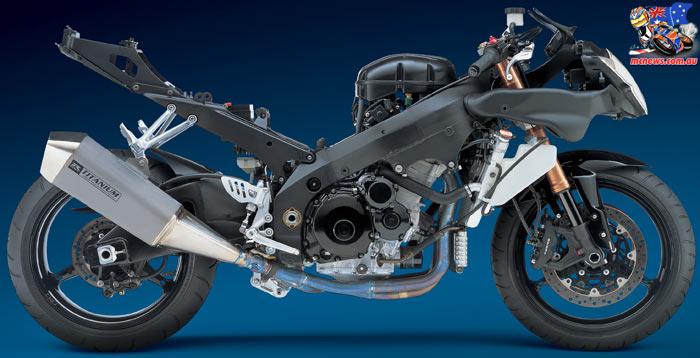
The same fully transistorised ignition from the K4 is retained for duties in 2005, while the exhaust and fuel injection systems have been revised. The exhaust system is titanium from front to back, and that new muffler that has everyone talking is what Suzuki have dubbed SAES or Suzuki Advanced Exhaust System. The muffler not only offers good cornering clearance, it also reduces drag and sounds bloody great for a stock system. Suzuki’s SET exhaust valve system is incorporated into the exhaust and is controlled by the ECM with input from engine rpm/throttle position/gear position.
The single-injector per cylinder system from the K4 has been replaced with twin-injectors per cylinder combined with the same SDTV, or Suzuki Dual Throttle Valve, set up. Throttle bodies are increased 2mm in diameter to 44mm, and intake diameters increased from 50mm to 52mm.
The new multi-hole injectors produce a finer fuel spray and better fuel atomisation, resulting in more efficient combustion and a quicker, smoother throttle response. The twin injector system comprises of a primary and a secondary injector per cylinder. The primary injector is positioned in the intake port, the secondary injector in the airbox side of the inlet tract. The primary injector operates under all conditions, while the secondary injector sprays fuel directly onto the secondary throttle butterfly at high rpm, under heavy load or wide-open-throttle. The 2005 GSX-R1000 runs the same PAIR emissions-reduction system as the K3/4.
— Chassis and Styling —
The 2005 GSX-R1000 is much more compact in every dimension than previous models. The K5 is 40mm shorter front to rear, 15mm shorter from top to bottom and 5mm narrower. The seat is 20mm lower and the ‘bar reach is a staggering 40mm shorter. The distance between the footpegs is 17mm narrower and the pegs are lower. Rake is increased from 23.5mm to 23.8mm with 5mm more trail at 96mm.
The new frame layout concentrated vehicle mass towards the front of the bike to increase agility. The distance from the headstock to the crank is reduced by 3mm while the distance from the swingarm pivot to the crank is also reduced by 3mm – in other words the horizontal distance is reduced by a combined 6mm. The headstock, main spars and upper engine mounts are formed by a single cast for 2005, linked by two extruded, tapered spars to a cast swingarm pivot. The sub-frame is made of two cast sections, replacing the conventional extruded alloy box-section sub-frame of the previous model.
The K5 swingarm is all-new and features a single-cast-section pivot tube, front deck, cross brace and forward arm section. Another casting forms the inner arm and wall and axle carrier plates and the outer walls are stamped aluminium. Rigidity has been calculated to give optimum feel and performance. Race kit adjustable pivot spacers are available as part of the race kit.
The Kayaba inverted front forks remain fundamentally the same as last year although the DLC, or Diamond Like Coating, treatment has been improved and valving revised. The Kayaba rear shock has been re-designed with a new stroke of 335mm and new valving. The linkages are also revised.
All new wheels grace the new Gixer. The sizes remain 3.50 x 17in (f) and 6.00 x 17in (r) but thinner spokes and a new shape have reduced unsprung weight significantly. Pulling the K5 up are the same Tokico radial-mount calipers as before, though this time biting on 310mm rotors (f) via an all-new radial master-cylinder. The rear brake is unchanged.
Overall styling is completely revised. The Gixer now sports a combination of round surface, flat surfaces and sharp edges, offering a much more aggressive look than before.
The vertically stacked headlights look great and also allow for a better charging efficiency through intake design as the SRAD ram-air system can be located closer to the highest point of pressure. Both headlights are multi-reflector type and the top light is low-beam/bottom light high beam. LED rear taillights and a reshaped rear end have given the new Gixer a more modern look from behind, while the new, compact instrument cluster now features a gear position indicator. The fairings and graphics are all new.
— Weight Reduction Breakdown (grams) —
Frame – 1200g
Wheels – 500g
Fuel Tank – 350g
Pegs – 100g
ECM – 30g
Battery -500g
Generator – 400g
Valves – 94g
Pistons – 32g
Cylinder head bolts – 57g
Cam cover bolts – 28g
Now for the riding…
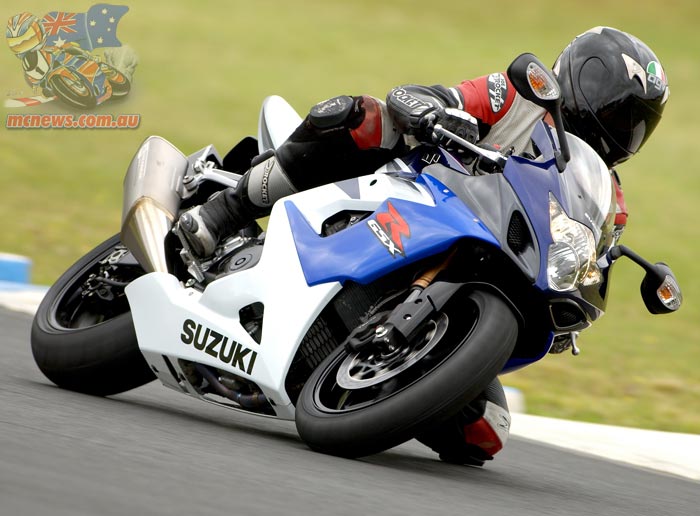
My initial impression as I climb aboard the K5 is the same as when I first rode the 750 and 600 K4s – the reduction in bulk has me shaking my head in amazement. The 1000 is tiny. In fact, Suzuki engineers proudly point out that the 1000 is smaller than the 600. I’m comfortable, though, and apart from missing the extra control on offer from the wider footpegs of the K4 my 185cm/95kg frame suits the more compact GSX-R better than ever. Go figure…
With controls adjusted and a bit of a stretch we head out for our compulsory sighting laps behind a Japanese test rider. Three laps at a moderate pace is hard to deal with on a bike like this and as soon as I’m let out alone I’m into it – the new Gixer and I getting a feel for each other from the off. That’s the advantage of having a world launch at my home track. No corners to learn. No braking points to find. No unexpected bumps to send me off line. And I’m thankful, too, as the 1000 really isn’t the kind of machine I’d want to ride when I’m not quite on the job – particularly on this typically hot February day when Eastern Creek is a little slick and a lot more difficult than is usually the case.
Not that the new GSX-R1000 is hard to ride. Quite the opposite in terms of power delivery and chassis performance – but open that throttle and a whole new universe opens up. A level of performance that is as demanding and on-edge as anything on offer from a high-end race bike a few years back. In fact, the superbikes I raced five or six years ago were pussycats compared to this. And they were factory-supported jobbies…
Believe me. You need to be focussed to ride the Gixer hard but the rewards are much higher than ever before.
With a warm set of BT014 hoops ready for business, I put my head down and cut some fast times. I was here on a K4 just a few weeks ago but I’d never guess I was on a GSX-R today. The bike is performing almost flawlessly as I get more and more comfortable and settled. The thing I’m noticing most is the way the bike steers. Gone is the old way of the Gixer; end-of-the-‘bars-and-hold-her-down steering. The K5 turns-in accurately and easily on or off the anchors and once on its side the bike is holding a line and tracking through turns like it is on rails. No need to hold the K5 down mid-turn and no need to get off the throttle to get the front down like on the K4. The K5 just falls on its side and responds to the smallest footpeg and ‘bar inputs to adjust lean angle or line. The vagueness of the K4 front end is still there but nowhere near as bad. However, a combo of the BT014s lack of feel and the negative-preload fork set-up means that the uneasy feeling in the front when the throttle is cracked off a turn is still lingering slightly. It is a problem that I was hoping Suzuki would have fixed but to be honest the forks feel exactly the same as the K4 units to me – even the valving feels the same and I think you’d have to be a factory rider to note the differences.
Once the throttle is open the GSX-R settles very quickly and tracks true. The new rear suspension set-up and the ultra-linear power delivery working together to provide a very controllable package off the turns.
There’s no real ‘hit’ from the new powerplant – just a smooth flow of endless torque and power that is accessed well through the new close-ratio ‘box. Things do get busy from 8000rpm and again from 9500rpm but basically it is all smooth power from go to whoa. And with a 13,500rpm rev ceiling the Gixer certainly screams.
Throttle inputs are very accurate and smooth and as I clock up 10 or so laps and the rear Bridgestone begins to squirm I find myself playing with the tube out of the uphill turn five and out of turn 12 – laying a few blackies and having a bit of fun. It is all too easy and controllable but man, is it fast. Turn five is usually a second gear exit but in order to keep the front wheel on the ground I’m having to use third gear – and on to the chute in third, where I snatch fourth over the crest the K5 just wants to wheelstand. It isn’t just me, either, as multiple Aussie Superbike Champ and Suzuki factory rider Shawn Giles tells me later that he is using third out of turn five. Kevin Schwantz chooses second and smokes it instead! Torque is the word.
Top speed down the front chute is, based on my riding and times, up on last year. Having stacked at the ultra-fast turn one numerous times I always button off a little at the end of the straight – usually at an indicated 270km/h. But the GSX-R1000 sucked me in to 280km/h and beyond more than once. I’m only guessing but as a factory superbike usually hits an accurate 275km/h at Eastern Creek I’d say the new K5 must be pulling at least a true 260 to 265km/h. Nothing to laugh at, that’s for sure…
The induction roar is much more prominent on the K5 than it was on the K4, and as I tuck-in down the chute I almost feel like I’m on a race bike because the exhaust is loud, too. The end of the straight is awesome on the Gixer. It is normally such a busy and scary turn-in. You literally have to sit-up, set-up and go down two gears between the 150 and 100 – metre markers and if you miss the turn-point you’re gone. But I’m reeling in the luxury of a slipper clutch and every lap it’s just a matter of slamming it down to fourth and peeling in. No big rev. No clutch. No compression lock-up and no soiled undies! Suzuki really has gotten serious about racing all over again.
But it isn’t all about the track – as 99 per cent of these K5s will live on the streets. With no road ride incorporated into the launch I could only look at the wider picture but from early indications I think it would be safe to say that, with such easy power deliver, stability and compliancy I think the GSX-R1000 K5 is going to be a brilliant road bike, too.
Stability on the brakes is outstanding and, again, the slipper-clutch is the trick. It makes backing it in a little harder, though, but we’re not here to show off today. We’re here to reassure Suzuki that they’ve moved in the right direction with their now-without-doubt class-leading superbike. And I certainly have no doubts. The new GSX-R is lighter, more powerful, more refined and more stylish than ever before and there’s no better way to compliment Suzuki on the 20th anniversary of the GSX-R range than to give the nod to the K5. It is a truly inspiring machine and this could be the first of a whole new generation of sportsbikes…
The machine has also hit the racetrack and sprinted straight to the top of the timesheets with the most recent World Superbike pre season official test session seeing the only two Suzuki’s in the field finish 1-2 on the timesheets, Yukio Kagayama and Troy Corser at the helm. If the machine is showing that sort of speed already how fast could it prove after more track development…?
SPECS – 2005 Suzuki GSX-R1000
Suzuki GSX-R1000
Engine: 999cc, four-stroke, liquid-cooled, DOHC, four-cylinder
Claimed Power: 178ps
Claimed Torque: 118Nm
Bore x Stroke: 73.4 x 59mm
Induction: EFI with 4 x 44mm throttle bodies
Starter: Electric
Transmission: Six speed
Final Drive: Chain
Wheelbase: 1405mm
Dimensions (L x W x H): 2030 x 710 x 1130mm
Seat Height: 810mm
Dry Weight: 166kg
Fuel Capacity: 18 litres
Tyres: Front _ 120/70ZR17; Rear _ 190/50ZR17Suspension: Front _ Fully adjustable inverted telescopic forks; Rear _ Fully adjustable single shock
Brakes: Front _ 310mm discs, radial mounted four-piston calipers; Rear _ 220mm single disc
Price: TBC
Warranty: Two years, unlimited kilometres
Available: April/May 2005 (Approx.)
